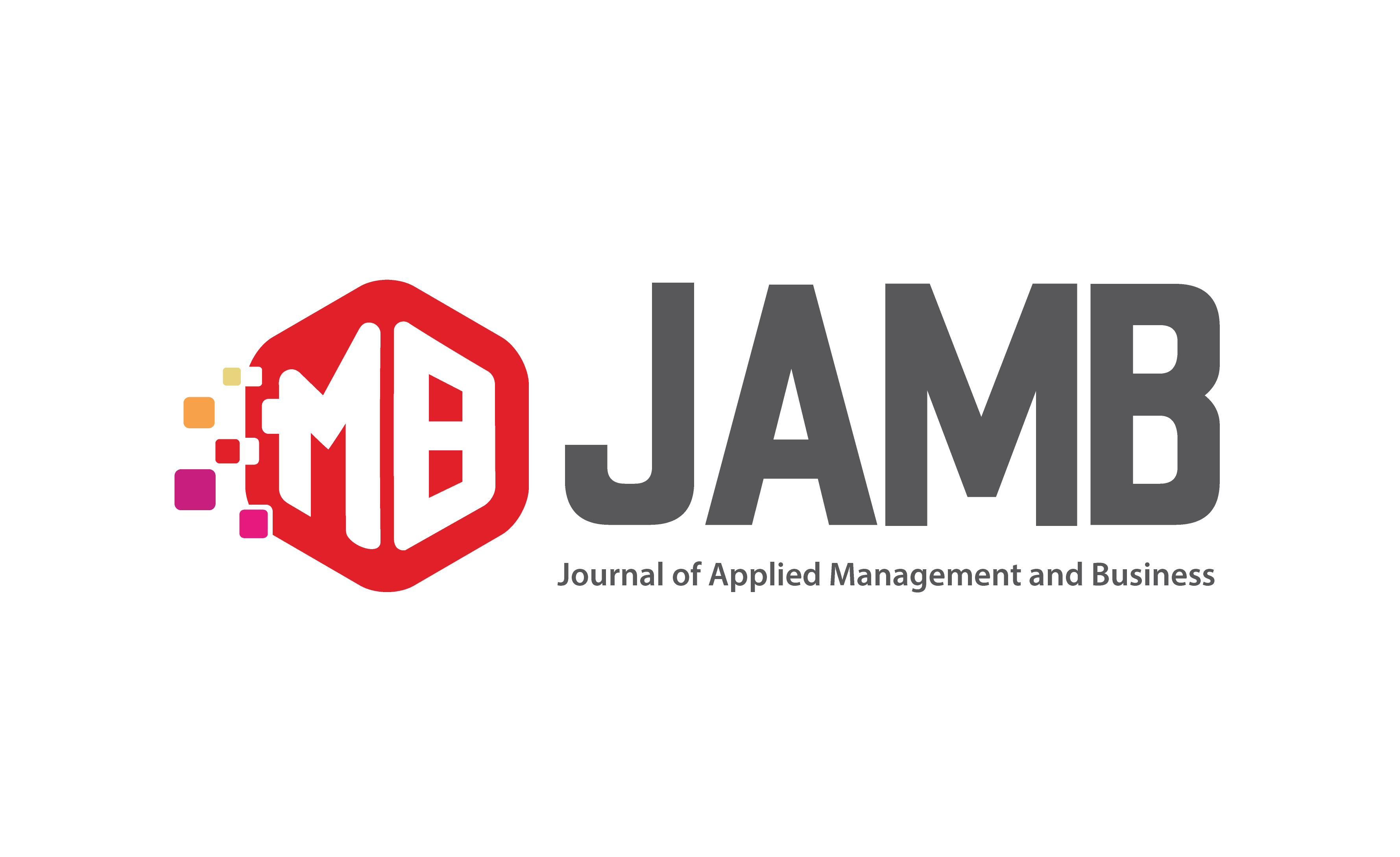Analysis of Factors Affecting Community on the Use of Non-Cash Payment Tools in Taman District, Sidoarjo Regency
DOI:
https://doi.org/10.37802/jamb.v2i1.155Keywords:
Theory Acceptance Model, Benefit, Convenience, Trust, RiskAbstract
The purpose of the study was to examine the effect of perceived benefits, convenience, trustworthiness, and risk on the use of non-cash payment instruments in Taman Sub-district, Sidoarjo Regency. The Theory Acceptance Model (TAM) is used as the theoretical basis for the research. The research sample is people who transact at Alfamart, Indomaret, McDonald's Geluran, and Alfamidi in Taman sub-district, Sidoarjo district. Multilevel random sampling method. The questionnaires distributed were 100 respondents. The results showed that trust had no effect, while the benefits, convenience, and risk had an effect on noncash payment instruments.
Downloads
References
Achmat, Z. (2010). Theory of Planned Behavior, Masihkan Relevan. http://zakarija. staff. umm. ac.id/files/20, 10, p.12.
Ajzen, I. and Fishbein, M.A. (1980). Understanding Attitudes and Predicting Social Behavior. Prentice Hall Inc. Englewood Cliffs. NJ.
Ajzen, Icek. (1991). The Theory of Planned Behaviour. Organizational Behaviour and Human Decision Process, 50, 179-2011.
Hanif Astika Kurniawati, Wahyu Agus Winarno, Alfi Arif. (2017). Analisis Minat Penggunaan Mobile Banking Dengan Pendekatan Technology Acceptance Model (TAM) Yang Telah Dimodifikasi. e-Journal Ekonomi Bisnis dan Akuntansi, 4(1),24-29.
Carlos Flavian and Miguel Guinalıu.(2006). Consumer trust, perceived security and privacy policy three basic elements of loyalty to a web site. Industrial Management & Data Systems, 106(5), 601-620.
Davis,F. (1986). A technology acceptance model for empirically testing new end-user information systems: theory and results. Doctoral dissertation. MIT Sloan School of Management. Cambridge. MA.
Davis, F.D. (1989). Perceived usefulness, perceived ease of use, and user acceptance of information technology. MIS Quarterly, 13 (3), 319–340.
Firdayanti, R. (2014). Persepsi Risiko Melakukan E-Commerce dengan Kepercayaan Konsumen dalam Membeli Produk Fashion Online. Journal of Social and Industrial Psychology, 2(4),1-12.
Ghozali, I. (2018). Aplikasi analisis multivariate dengan program IBM SPSS 25. semarang: Badan penerbit universitas Diponegoro.
I.M., Al-Jabri. (2015). The Intention to use Mobile Banking: Further evidence from Saudi arabia. Departmen of accounting and MIS, College of Industrial Management, King Fahd University.
Kumar, V.V. Ravi., Lall, Anurag., Mane, Tanmay. (2017). Extending The TAM Model: Intension Of Manajement Student to Use Mobile Banking: Evidence From India. Global Bussiness Review, 238-249.
Lafraxo, Y., Hadri, F., Amhal, H. and Rossafi, A. (2018).The Effect of Trust, Perceived Risk and Security on the Adoption of Mobile Banking in Morocco. DOI: 10.5220/0006675604970502 In Proceedings of the 20th International Conference on Enterprise Information Systems (ICEIS 2018), 497-502.
Liao, C., Lin, H.N. and Liu, Y.P. (2010). Predicting the use of pirated software: A contingency model integrating perceived risk with the theory of planned behavior. Journal of Business Ethics, 91(2), 237-252.
Madden, T. J., Ellen, P. S., & Ajzen, I. (1992). A Comparison of the Theory of Planned Behavior and the Theory of Reasoned Action. Personality and Social Psychology Bulletin, 18(1), 3–9. doi:10.1177/0146167292181001 DOI : ttps://doi.org/10.1177/0146167292181001.
Maroofi, Fakhraddin., Fatemeh, K., Dehghani, M,. (2013). An Investigation of Initial Trust on Mobile Banking. International Journal of Academic Research In Business and Social Sciences. 3(9).
Mulyati, Bambang Sugiharto, Prini Nurtina Dewi. (2020). Perceptions Of Usefulness And Perceptions Of Easiness To Employees Interest In Using Fintech. Accounting Research Journal of Sutaatmadja (ACCRUALS). 4(2), 244-252. DOI : https://doi.org/10.35310/accruals.v4i02.611.
Octavia, D., & Hafizh, M. D. (2019). Faktor –Faktor Yang Mempengaruhi Persepsi Konsumen Epayment (Studi Kasus: Pengguna Kartu Kredit dan Debit di Kota Bandung). Jurnal Manajemen Indonesia. Online ISSN: 2502-3713. Print ISSN: 1411-7835.Universitas Telkom,19(1), 1–9. https://doi.org/10.25124/jmi.v19i1.1980.
Prabawani, P. (2017). pengaruh manfaat, kemudahan penggunaan, dan risiko terhadap minat menggunakan layanan uang elektronik (studi kasus pada masyarakat di kota semarang). jurnal administrasi bisnis, 1-9.
Sugiyono. (2017). Statistika untuk penelitian . Bandung: Alfabeta.
S. Priambodo, and B. Prabawani.(2016).Pengaruh Persepsi Manfaat, Persepsi Kemudahan Penggunan, Dan Persepsi Risiko Terhadap Minat Menggunakan Layanan Uang Elektronik (Studi Kasus pada Masyarakat di Kota Semarang). Jurnal Ilmu Administrasi Bisnis, 5(2), 127-135.
Utami, S., & Kusumawati. (2017).Faktor-Faktor yang Mempengaruhi Minat Menggunakan E-money.Jurnal Balance,14(2).
Wibowo, S., & Rosmauli, D. (2015). Pengaruh Persepsi Manfaat, Persepsi Kemudahan, Fitur Layanan, dan Kepercayaan Terhadap Minat Menggunakan e-money Card. Jurnal Riset Manajemen Sains Indonesia, 6(1).
Wildan, Muhammad (2019) Pengaruh Persepsi Kemudahan Penggunaan, Efektivitas Dan Risiko Terhadap Minat Bertransaksi Menggunakan Financial Technology (Fintech). Skripsi. UIN Walisongo Semarang.
Yani, E., Lestari, A. F., Amalia, H., Puspita, A. (2018). Pengaruh Internet Banking Terhadap Minat Nasabah Dalam Bertransaksi Dengan Technology Acceptance Model. Jurnal Informatika. 5 (1). 34-42.











